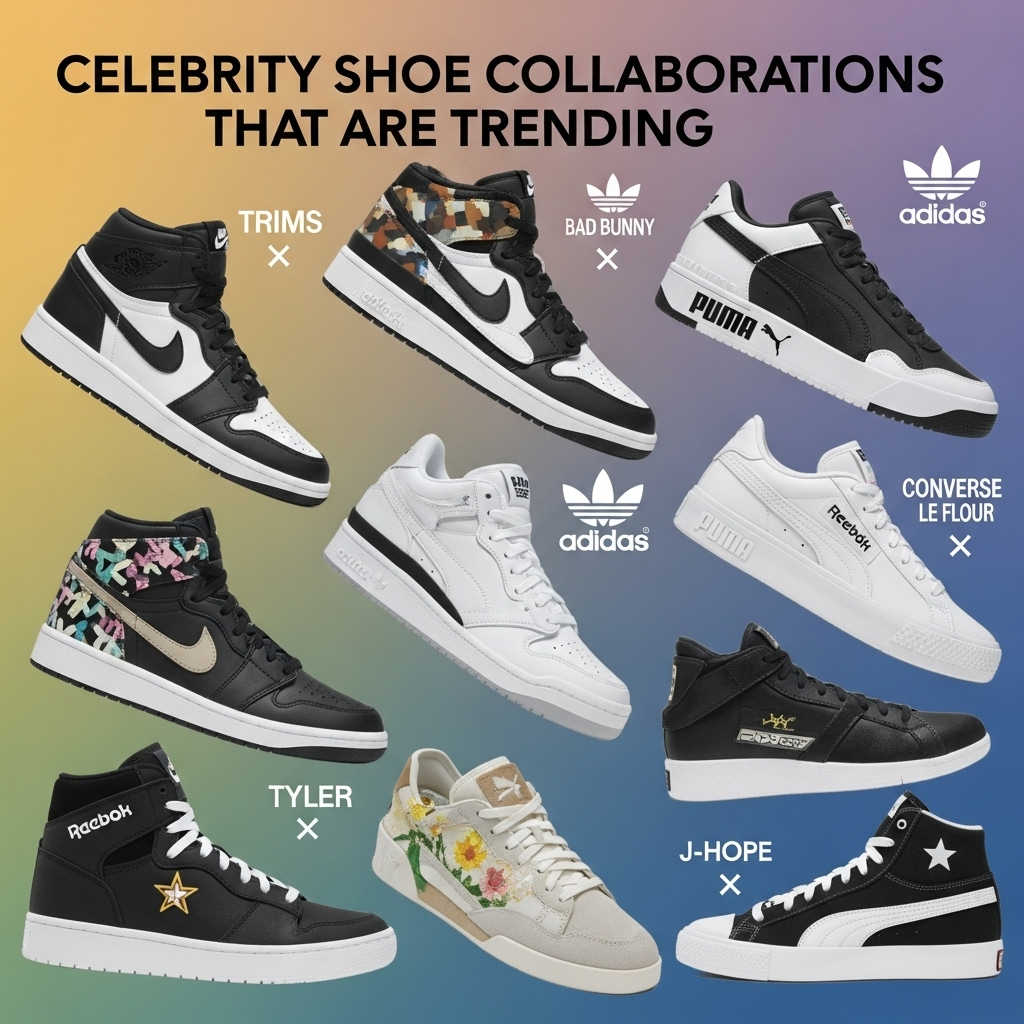The footwear industry has undergone a seismic shift in recent years, with celebrity collaborations becoming the heartbeat of innovation and desirability. What was once a niche marketing tactic has evolved into a $10 billion+ engine driving consumer engagement, cultural relevance, and unprecedented revenue streams. Today’s consumers don’t just buy shoes—they buy stories, identities, and connections to their favorite personalities. As a marketing director in the footwear space, I’ve witnessed firsthand how these partnerships transform ordinary products into cultural artifacts overnight. The most successful collaborations blend authenticity with innovation, creating products that resonate emotionally while pushing design boundaries. In 2024, we’re seeing an unprecedented convergence of sports, music, fashion, and pop culture in footwear collaborations that are redefining how consumers interact with brands.
The magic happens when celebrities bring their unique perspectives to footwear design, rather than simply lending their names to pre-existing templates. This shift from endorsement to co-creation has elevated sneaker culture from a subculture to a mainstream phenomenon. When Travis Scott told Complex that his relationship with Nike “started when I was a kid, even if they didn’t know it at the time,” he articulated the authentic connection that drives successful collaborations. Today’s consumers—particularly Gen Z and millennial shoppers—demand this level of authenticity and are willing to pay premium prices for products that feel personally meaningful. The data is undeniable: collaborations consistently command 30-50% higher price points and sell out within minutes of release, with secondary market values often doubling or tripling.

The Evolution of Celebrity Footwear Collaborations
Sneaker culture as we know it owes its very existence to early celebrity partnerships that transformed footwear from functional items into cultural symbols. Run-DMC’s iconic relationship with Adidas in the 1980s fundamentally altered the industry, proving that musicians could make athletic footwear culturally significant beyond the court or field. Their 1986 hit “My Adidas” wasn’t just a song—it was a cultural manifesto that paved the way for future artist-brand relationships. Nelly further cemented this connection when he gave Nike’s Air Force 1s their own anthem with “Air Force Ones,” transforming what was once a basketball shoe into a streetwear staple. These early partnerships established a blueprint: when celebrities authentically embrace a product, they don’t just endorse it—they redefine its cultural value.
The modern era of collaborations has expanded far beyond hip-hop artists to include athletes, designers, and even fictional characters. As Rap-Up notes, “Sneakers owe much of their existence to Hip Hop,” but today’s landscape features diverse voices shaping footwear culture. Singers like Rihanna and Beyoncé have leveraged their massive influence to create lines that blend fashion and function, while athletes like LeBron James have built entire ecosystems around their signature footwear. The industry has evolved from simple endorsement deals to true creative partnerships where celebrities serve as designers, brand ambassadors, and cultural curators. This shift has democratized sneaker culture, making it accessible to wider audiences while maintaining its aspirational quality. Today’s collaborations often tell a story of personal journey, cultural identity, and creative vision that resonates far beyond the footwear itself.
2024’s Most Impactful Celebrity Shoe Collaborations
This year has witnessed some of the most innovative and culturally significant footwear collaborations in recent memory, with WNBA stars emerging as particularly powerful partners. A’ja Wilson, Angel Reese, and Caitlin Clark have secured major deals that reflect the growing influence of women’s basketball and the expanding market for female-focused footwear. As WWD reports, these athletes were “responsible for some of 2024’s buzziest sneaker endorsement deals,” signaling a major shift in how brands approach athlete partnerships. Their collaborations aren’t just about performance—they’re about representation, community, and connecting with a new generation of consumers who see these athletes as cultural icons beyond the court.
| Celebrity | Brand Partner | Key Innovation | Market Impact |
|---|---|---|---|
| A’ja Wilson | Nike | Performance-focused design with women’s-specific engineering | First WNBA player with dedicated signature line |
| Lewis Hamilton | Dior | Luxury meets performance with sustainable materials | Blurred lines between high fashion and athletic wear |
| Bad Bunny | Crocs | Bold colorways and cultural references | Drove 40% increase in Crocs’ youth market share |
| Zendaya | On | Eco-conscious running shoes with aesthetic appeal | Attracted new female demographic to performance brand |
| Donald Glover | Adidas | Artistic expression through limited edition releases | Created cult following among creative communities |
These partnerships represent a fundamental shift in how brands approach collaborations. Rather than treating celebrities as mere endorsers, forward-thinking companies are building genuine creative partnerships that leverage the star’s authentic voice and perspective. Donald Glover’s 2019 “Donald Glover Presents” collaboration with Adidas, as highlighted by Yahoo Style, exemplifies this approach—a “true masterpiece of artistry and creative expression” that went beyond typical celebrity partnerships. Similarly, Travis Scott’s ongoing relationship with Nike has redefined what a sneaker collaboration can be, with his designs consistently selling out within minutes and commanding premium prices on the secondary market.
High-Fashion Meets Streetwear: Luxury Brand Collaborations
The boundary between high fashion and streetwear has all but disappeared, with luxury brands increasingly turning to unexpected collaborations to stay relevant with younger consumers. Dior’s partnership with Lewis Hamilton represents a sophisticated fusion of performance and luxury, while Stella McCartney’s ongoing work with Adidas has created a sustainable athletic wear line that appeals to eco-conscious consumers. Perhaps most surprising has been Jimmy Choo’s dive into pop culture with a collaboration featuring Sailor Moon, the beloved Japanese manga heroine. As FashionNetwork reports, this autumn collection brings “pop culture icon and super-heroine Sailor Moon from the eponymous manga series drawn by Japanese manga artist Naoko Takeuchi” to the forefront of luxury footwear.
These high-fashion collaborations have fundamentally changed how consumers perceive luxury footwear, making it more accessible while maintaining exclusivity. The Jimmy Choo x Sailor Moon collection, for instance, taps into the “kawaii” aesthetic that has become increasingly influential in global fashion. Similarly, Ganni’s recent partnership with New Balance, unveiled during Paris Fashion Week, created a “leopard pair” that blended high fashion with accessible sneaker culture. What’s remarkable about these collaborations is how they’ve expanded the traditional luxury consumer base, attracting younger shoppers who might never have considered luxury footwear before.
The success of these partnerships demonstrates that today’s consumers don’t want to choose between high fashion and streetwear—they want both. Brands that can successfully bridge this gap are seeing unprecedented engagement, with collaborations often selling out immediately and generating significant social media buzz. The key to success lies in authenticity: when the partnership feels genuine and reflects the values of both the celebrity and the brand, consumers respond with enthusiasm and loyalty.
The Cultural Impact of Celebrity Footwear Partnerships
Celebrity shoe collaborations have evolved from marketing tactics into powerful cultural forces that shape how we express identity, community, and values. When Bad Bunny collaborated with Crocs, he didn’t just create a shoe—he validated a cultural moment, giving permission to a generation to embrace comfort and self-expression without compromise. As Footwear News notes, Crocs’ credibility in the fashion world “skyrocketed after the Balenciaga co-sign,” demonstrating how collaborations can transform perceptions of entire brands. What was once considered unfashionable became a status symbol through the power of celebrity association.
These partnerships have also democratized fashion in unprecedented ways. Whereas high fashion was once accessible only to the elite, celebrity collaborations bring luxury and design innovation to mainstream consumers. The success of collaborations like Justin Bieber’s with Crocs or Salehe Bembury’s designer partnerships shows that today’s consumers value authenticity and personal connection over traditional status markers. The most successful collaborations create communities around products, turning customers into brand advocates who share their purchases across social media and drive organic engagement.
| Cultural Impact | Description | Example |
|---|---|---|
| Identity Expression | Footwear as personal storytelling | Travis Scott’s designs reflecting his Houston roots |
| Community Building | Shared ownership of cultural moments | Limited drops creating shared excitement |
| Value Redefinition | Shifting what’s considered fashionable | Crocs becoming high-fashion staples |
| Cultural Validation | Celebrities legitimizing subcultures | Bad Bunny celebrating Latin culture through design |
The cultural influence of these collaborations extends far beyond sales figures. They shape trends, influence social discourse, and even impact how we perceive ourselves and our communities. When a celebrity like Zendaya partners with a performance brand like On, it sends a message about who belongs in certain spaces and what kinds of stories get told in the footwear world. These partnerships aren’t just selling shoes—they’re selling visions of identity, community, and possibility.
Pro Tip: Navigating the Collaboration Landscape
As a marketing director with years of experience in the footwear industry, my number one recommendation for brands considering celebrity collaborations is to prioritize authenticity over star power. A partnership with a celebrity who genuinely loves and understands your brand will always outperform a high-profile but inauthentic partnership. Before pursuing any collaboration, conduct thorough cultural research to ensure the partnership aligns with both your brand values and the celebrity’s authentic voice. The most successful collaborations—like Travis Scott’s ongoing relationship with Nike—feel organic because they’re built on genuine mutual respect and shared creative vision.
I also recommend focusing on creating collaborative processes that give celebrities real creative input rather than just using them as marketing tools. When Donald Glover approached his Adidas collaboration, he treated it as “a true masterpiece of artistry and creative expression,” which resonated deeply with consumers. Brands should be prepared to relinquish some control and embrace the creative vision their partners bring to the table. Finally, plan for long-term relationship building rather than one-off transactions—Travis Scott’s enduring partnership with Nike has created more value through multiple releases than a single blockbuster collaboration ever could.
The Future of Celebrity Footwear Collaborations
Looking ahead, I anticipate even more innovative and boundary-pushing collaborations as brands continue to explore new partnerships and formats. The rise of digital collectibles and NFTs is already creating new opportunities for limited-edition releases that blend physical and digital ownership. We’re also seeing increased focus on sustainability, with celebrities like Stella McCartney leading the way in creating eco-conscious footwear that doesn’t compromise on style or performance.
The most exciting development, however, is the democratization of collaboration opportunities. While major brands and A-list celebrities will continue to dominate headlines, we’re seeing more micro-influencers and niche creators partnering with footwear brands to reach specialized audiences. This trend toward more diverse partnerships will make sneaker culture even more inclusive and representative of the broader consumer landscape.
As the lines between celebrity, creator, and consumer continue to blur, the future of footwear collaborations will be defined by authenticity, community, and shared values rather than star power alone. Brands that understand this shift and build genuine partnerships based on mutual respect and creative vision will thrive in the increasingly competitive footwear market. The most successful collaborations of tomorrow won’t just sell shoes—they’ll create cultural moments that resonate far beyond the initial product release.
For consumers, this means more exciting, innovative products that reflect diverse perspectives and values. For the industry, it represents an unprecedented opportunity to build meaningful connections with consumers who want to express their identities through the products they wear. As we move forward, the most successful footwear brands will be those that embrace collaboration not just as a marketing tactic, but as a fundamental way of creating and engaging with culture. The era of celebrity shoe collaborations has evolved from novelty to necessity, and those who understand this shift will lead the industry into its next chapter.
